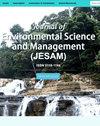菲律宾洛杉矶市不可生物降解废物的生态足迹核算:人为向可生物降解物的转变
IF 0.3
4区 环境科学与生态学
Q4 ENVIRONMENTAL SCIENCES
Journal of Environmental Science and Management
Pub Date : 2020-12-27
DOI:10.47125/jesam/2020_sp1/05
引用次数: 0
摘要
本研究使用2015年废物分析和表征总结,考虑了菲律宾洛杉矶市城市固体废物的生态足迹核算,并将预测细分为Angeleǹos的固体废物,以人均废物产生量表示,描述了废物消耗水平、城市栖息地质量,以及根据人口增长率和分流率加快废物处理。使用生态足迹会计对结果进行定量分析,并通过效益成本分析对结果进行货币解释。主要的研究过程包括:分析人均废物产生量;废物预测扣除了对不可生物降解物的定向转移;转移废物的成本分析;以及可回收物的收入分析。未来五年的废物产生将90%由家庭产生;10%由教育和其他机构提供。废物成分为37%可生物降解,20%可回收,43%不可生物降解。到2022年,尽管人口增长了136%或相当于561000个成分,但该市预计将产生159公斤yr-1∙106的废物,减少率为96.89%。最后,五年效益成本分析产生了9.55亿菲律宾比索的预算节约,相当于740万美元,或平均每年节省39%的市政成本本文章由计算机程序翻译,如有差异,请以英文原文为准。
Ecological Footprint Accounting of Non- Biodegradable Wastes of Angeles City, Philippines: The Anthropogenic Shift to Biodegradables
This study factored the Ecological Footprint Accounting on the Municipal Solid Wastes of Angeles City, Philippines using the Waste Analysis and Characterization Summary for 2015, with projections subdivided into the solid wastes of Angeleǹos, expressed as waste generation per capita, depict the level of waste consumption, quality of urban habitat, and the acceleration on waste disposal based on the population growth rate and diversion rate. The results were quantitatively analyzed using Ecological Footprint Accounting and interpreted in monetary terms through Benefit-Cost Analysis. The major research processes include: Analysis of waste generation per capita; Waste Projections net of targeted diversion on non-biodegradables; Cost Analysis on diverted wastes; and Income Analysis on Recyclables. The waste generation for the next five years will be generated 90% by households; 10% by educational and other institutions. With waste composition of 37% biodegradable, 20% recyclables and 43% non-biodegradable. By the year 2022, the city is expected to generate 159 kg yr-1∙106 with waste mitigation at a decreasing rate of 96.89% despite the population acceleration at 136% or equivalent to 561,000 constituents. Lastly, the five-year Benefit-Cost Analysis yielded a budgetary savings of PhP395M, equivalent to US$ 7.4M or an average municipal annual cost savings of 39%
求助全文
通过发布文献求助,成功后即可免费获取论文全文。
去求助
来源期刊

Journal of Environmental Science and Management
ENVIRONMENTAL SCIENCES-
CiteScore
0.90
自引率
0.00%
发文量
10
审稿时长
2 months
期刊介绍:
The Journal of Environmental Science and Management (JESAM) is an international scientific journal produced semi-annually by the University of the Philippines Los Baños (UPLB).
JESAM gives particular premium to manuscript submissions that employ integrated methods resulting to analyses that provide new insights in environmental science, particularly in the areas of:
environmental planning and management;
protected areas development, planning, and management;
community-based resources management;
environmental chemistry and toxicology;
environmental restoration;
social theory and environment; and
environmental security and management.
 求助内容:
求助内容: 应助结果提醒方式:
应助结果提醒方式:


